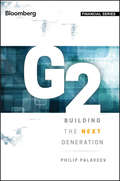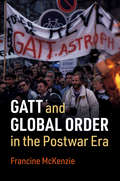- Table View
- List View
G.D.H. Cole and British Sociology: A Study in Semi-Alienation
by Matt DawsonThis book explores G.D.H Cole’s significant yet often overlooked role in the history of British Sociology from 1920-1960. Eager to achieve a sense of scientific legitimacy following its institutionalisation in the early 1900s, British sociology had no space for a scholar like Cole, who saw sociology as an innately normative and political project which, in his case, was dedicated to the development of socialism. Conceptualising Cole's relationship to sociology as one of semi-alienation - suggesting an openness to the principles of the discipline yet disagreement with the form it takes in the current day - Dawson shows how Cole made a number of important sociological contributions which were grounded in an early form of structuration theory, including the production of one of Britain’s first sociology textbooks and an early monograph on the sociology of class. A passionate advocate for what sociology could be, Cole was a promoter of the sociological Marx and interrogator of Durkheim as part of his desire to develop sociology in Britain, including at his own institute of the University of Oxford. Cole also produced a distinctive corpus of public and creative sociology expressed in newspaper articles, poems and songs. Drawing on archival research Dawson reintegrates Cole into the history of British Sociology, and in so doing offers valuable insight into sociology's history and its contemporary form, emphasising a normative, critical and public form of the discipline.
G.G. Toys
by Dennis Campbell Susan KulpThis case highlights issues of management accounting and includes a review of product costing, excess capacity, variance analysis, and scrap costs.
G.I. JOE: Marketing an Icon
by Gail McgovernIn the winter of 2003, Billy Lagor, the Hasbro toy company's brand manager for G.I. JOE, faced a set of decisions that would ultimately determine the 2004 marketing plan for the G.I. JOE brand. Under consideration were three different ways to market the military action figure: use traditional media: supplement traditional media with a short, animated DVD; or rely entirely on nontraditional marketing. In evaluating these options, Lagor grappled with a more basic question: What is the nature of the G.I. JOE and Hasbro brands? Should he market G.I. JOE as a short-term fad or as a marquee property akin to the Barbie franchise? Includes color exhibits.
G.I. JOE: Marketing an Icon
by Gail McgovernIn the winter of 2003, Billy Lagor, the Hasbro toy company's brand manager for G.I. JOE, faced a set of decisions that would ultimately determine the 2004 marketing plan for the G.I. JOE brand. Under consideration were three different ways to market the military action figure: use traditional media: supplement traditional media with a short, animated DVD; or rely entirely on nontraditional marketing. In evaluating these options, Lagor grappled with a more basic question: What is the nature of the G.I. JOE and Hasbro brands? Should he market G.I. JOE as a short-term fad or as a marquee property akin to the Barbie franchise? Includes color exhibits.
G.a.t.c.a.
by Ross K. Mcgill Christopher A. Haye Stuart LipoThis book is a practical guide to global anti-tax evasion frameworks. Coverage includes base erosion and profit shifting (BEPS), the Common Reporting Standard (CRS), and the Automatic Exchange of Information (AEoI). It covers the practical operational issues these frameworks present and offers insight into practical compliance options and operational methodologies to reduce costs and risks. The book concludes with insights into how institutions can translate these complex obligations into effective client communications.
G.l.s. Shackle
by Michael Jefferson Peter E. Earl Bruce LittleboyThis is an intellectual biography of G. L. S. Shackle, economic theorist, philosopher, and historian of economic theory. It explores how Shackle challenged the aims, methods and assumptions of mainstream economics. He stressed macroeconomic instability, and developed a radically subjectivist theory for behavioural economics and business planning.
G20 Economic Policy: A Balance of Payments Framework (Routledge-Giappichelli Studies in Business and Management)
by Marcello MinennaThis book examines the statistics of the G-20 members with the goal of providing an analysis of their economic policies, with a particular emphasis on the financial dynamics of each country's Balance of Payments, in order to offer a framework for better understanding where we are headed in an era of great economic and geopolitical reconfiguration.Furthermore, it delves into the current challenges to the US-led monopolar world that emerged after the collapse of the Soviet Union, beginning with the rise of China and India alongside Russia, and their potential role in reshaping the global financial system. The focus also extends to South America, where economies such as Brazil and Argentina are navigating complex relationships with traditional allies and emerging global powers. Africa's position in this evolving landscape is also analyzed, highlighting its growing autonomy as exemplified by the African Union's inclusion in the G-20. Furthermore, the Middle East is undergoing a remarkable geopolitical shift, undoubtedly representing another node of power in the emerging economic chessboard. These geopolitical dynamics are further complicated by major global events, including the 2008 global financial crisis, the Eurozone sovereign debt crisis, the COVID-19 pandemic in 2020, and the Russo-Ukrainian conflict in 2022. Pressing challenges are also posed by the climate emergency, highlighting its direct impact on productivity and migration patterns.Finally, this book seeks to contribute to a nuanced understanding of the current economic realities of key global actors and their complex interplay with geopolitical choices. Based on a scholarly approach, the analysis provides insights into the complex and evolving global order.
G20 Entrepreneurship Services Report
by Jian Gao Ruitao Jia Qing SuThis book focuses on the progress of G20 members on entrepreneurship services since the G20 Entrepreneurship Action Plan was issued at the G20 Hangzhou Summit in China. The authors analyse the similarities and differences of policy measures taken by G20 members from five aspects of entrepreneurship services: government services, fiscal and financial supports, entrepreneur services, entrepreneurship education, and fair competition for SMEs. The book aims to bridge academic research with the multilevel and diverse practice in entrepreneurial activities and explores how national policies and conditions can promote entrepreneurship among G20 members. This book will inspire the policy- makers, stakeholders in the entrepreneurship ecosystems and scholars on entrepreneurship research as well, on how to promote the entrepreneurship as an effective way to stimulate employment growth, boost innovation development, and realize economic recovery in the post- COVID-19 era.
G20 Governance for a Globalized World (Global Finance)
by John J. KirtonThis book offers the most thorough, detailed inside story of the preparation, negotiation, performance, and achievements of G20 gatherings from their start at the finance level in 1999 through their rise to become leader-level summits in response to the great global financial crisis in 2008. Follow the moves of America’s George Bush and Barack Obama, Britain’s Gordon Brown and David Cameron, Canada’s Stephen Harper, Germany’s Angela Merkel, and other key leaders as they struggle to contain the worst global recession since the Great Depression of the 1930s. This book provides a full chapter-long account of each of the first four G20 summits from Washington to Toronto with summaries of the ensuing summits. It uses international relations theory to build and apply a model of systemic hub governance to back its central claim to show convincingly that G20 performance has grown to successfully govern an increasingly interconnected, complex, crisis-ridden, globalized twenty-first century world.
G20 Since the Global Crisis
by Jonathan LuckhurstThis book analyzes the Group of Twenty (G20) since the 2008 financial crisis. The latter event undermined conventional wisdom and governance norms, constituting a more contested international economic regime. G20 leaders sought a cooperative response to the 2008 crisis through the forum, aware of their interdependence and the growing economic importance of key developing states. They agreed to new norms of financial governance based on macroprudential regulation, the Basel III Accords, and enhanced multilateral cooperation. They prioritized G20 cooperation for achieving international economic stability and growth. Differences exist over causes and effects of the crisis, including on the merits of economic austerity or fiscal stimulus strategies; on responsibility for and solutions to international economic imbalances; and concerns about monetary policies and "currency wars". Despite claims from skeptics that G20 cooperation is declining, this book argues its importance for international relations and as a hub of global governance networks.
G2: Building the Next Generation
by Philip PalaveevVital guidance to ensuring the future of your firm G2: Building the Next Generation provides financial advisory firms with a clear roadmap to management succession. Based on the author's 17 years of experience with over 1,000 firms, this book provides a systematic process to help you identify, develop, and install the new leadership that will guide your firm's future. Extensive statistical research backs proven strategies for structuring management and succession, overcoming obstacles, selling equity, and more, while expert guidance walks you through the process and warn you of potential pitfalls along the way. A generation of entrepreneurs used their talent and ambition to build an industry; to ensure that their success lives on, those leaders now face the formidable challenge of succession. With the future of your firm at stake, how do you recruit, train, mentor, and develop the next generation of professionals, owners, and leaders? This book shows you how to find the people you need, and develop them into the leadership your firm deserves. Identify and develop future leaders from the pool of existing and upcoming talent Structure management and management succession to ensure successful transition Begin selling equity to your firm's next generation of leaders Learn smart strategies for dealing with setbacks along the way The next generation of leaders will shape the future of your firm, but collectively, they will define the future of the entire advisory industry. Firms who succeed in developing their best talent will continue to thrive—those who fail will be left with a great car, but no driver. Getting this right may be one of the most critical points of your career, and it isn't something that should be left to chance or "gut feeling". G2: Building the Next Generation gives you a solid, grounded, systematic approach for ensuring your firm's long-lived success.
GAIN Positive and Mindful Self-Leadership: Toward Purpose Driven Insights
by Joan MarquesThis book proposes a new model, GAIN (Generating, Appreciating, Internalizing, and Newness) that shifts negative thinking patterns many find themselves in today’s society. Whether from extremely short-termed, thus unrealistic, expectations or general victim thinking, many people, particularly professionals, consider past experiences that don’t lead to immediate and tangible benefits as a waste of time. They forego long-span self-reflection to acknowledge their progress in life. This book uses mindful practices to shift these negative thought patterns into constructive ones that reveal personal purpose and growth, and thus, positive self-leadership and development. Featuring practices and exercises to support the GAIN model, this book will help readers see every life experience as a gain rather than loss, even if it may take some time to see the benefits from it, if at all.
GATT and Global Order in the Postwar Era
by Francine McKenzieAfter the Second World War, the General Agreement on Tariffs and Trade (GATT) promoted trade liberalization to help make the world prosperous and peaceful. Francine McKenzie uses case studies of the Cold War, the creation of the EEC and other regional trade agreements, development, and agriculture, to show that trade is a primary goal of foreign policy, a dominant (and divisive) aspect of international relations, and a vital component of global order. She unpacks the many ways in which trade was politicised, and the layers of meaning associated with trade; trade policies, as well as disputes about trade, communicated ideas, hopes and fears that were linked to larger questions of identity, sovereignty, and status. This study reveals how the economic and political dimensions of foreign policy and international engagement intersected, showing that trade was not only instrumentalised in the service of particular policies or relations but that it was also an essential aspect of international relations.
GCC Countries: From Oil Dependence to Diversification
by Ugo Fasano Zubair IqbalThis paper presents an overview of the unprecedented economic and social transformation witnessed by the member countries of the Cooperation Council of the Arab States of the Gulf (GCC)-Bahrain, Kuwait, Oman, Qatar, Saudi Arabia, and the United Arab Emirates-over the last three decades.
GCC Hydrocarbon Economies and COVID: Old Trends, New Realities
by Karen Young Nikolay Kozhanov Jalal QanasThe book considers the impact of COVID-19 on the GCC member states through the prism of challenges faced by their hydrocarbon sector. Yet, the publication’s discourse is not solely focused on the problems experienced by the oil and gas industries of the GCC member states after the beginning of the COVID pandemic. Instead, the contributors will analyze how these challenges and subsequent response to them affected other aspects of the GCC socio-economic and political development, from direct impact of the COVID on the energy sector of the GCC to socio-economic consequences of the oil market crisis for the region and its potential fallouts for the international relations of the Gulf.
GDP: A Brief but Affectionate History - Revised and expanded Edition
by Diane CoyleHow GDP came to rule our lives—and why it needs to changeWhy did the size of the U.S. economy increase by 3 percent on one day in mid-2013—or Ghana's balloon by 60 percent overnight in 2010? Why did the U.K. financial industry show its fastest expansion ever at the end of 2008—just as the world’s financial system went into meltdown? And why was Greece’s chief statistician charged with treason in 2013 for apparently doing nothing more than trying to accurately report the size of his country’s economy? The answers to all these questions lie in the way we define and measure national economies around the world: Gross Domestic Product. This entertaining and informative book tells the story of GDP, making sense of a statistic that appears constantly in the news, business, and politics, and that seems to rule our lives—but that hardly anyone actually understands.Diane Coyle traces the history of this artificial, abstract, complex, but exceedingly important statistic from its eighteenth- and nineteenth-century precursors through its invention in the 1940s and its postwar golden age, and then through the Great Crash up to today. The reader learns why this standard measure of the size of a country’s economy was invented, how it has changed over the decades, and what its strengths and weaknesses are. The book explains why even small changes in GDP can decide elections, influence major political decisions, and determine whether countries can keep borrowing or be thrown into recession. The book ends by making the case that GDP was a good measure for the twentieth century but is increasingly inappropriate for a twenty-first-century economy driven by innovation, services, and intangible goods.
GDPR For Dummies
by Suzanne DibbleDon’t be afraid of the GDPR wolf! How can your business easily comply with the new data protection and privacy laws and avoid fines of up to $27M? GDPR For Dummies sets out in simple steps how small business owners can comply with the complex General Data Protection Regulations (GDPR). These regulations apply to all businesses established in the EU and to businesses established outside of the EU insofar as they process personal data about people within the EU. Inside, you’ll discover how GDPR applies to your business in the context of marketing, employment, providing your services, and using service providers. Learn how to avoid fines, regulatory investigations, customer complaints, and brand damage, while gaining a competitive advantage and increasing customer loyalty by putting privacy at the heart of your business. Find out what constitutes personal data and special category data Gain consent for online and offline marketing Put your Privacy Policy in place Report a data breach before being fined 79% of U.S. businesses haven’t figured out how they’ll report breaches in a timely fashion, provide customers the right to be forgotten, conduct privacy impact assessments, and more. If you are one of those businesses that hasn't put a plan in place, then GDPR For Dummies is for you.
GDPR: How Small Businesses Can Win at the Compliance Game
by Samantha AlfordFor many small businesses, organisations, clubs, artists, faith groups, voluntary organisations/charities and sole traders, applying the General Data Protection Regulation (GDPR) has been like playing a game of "Snakes and Ladders". As soon as you move along the board and climb a ladder, a snake appears, which takes you right back to where you started. Conflicting advice abounds and there is nowhere for these individuals to go for simple answers all in one place. With the threat of fines seeming around every corner, now more than ever is the time for smaller organisations to get to grips with GDPR so that they can demonstrate their compliance. GDPR: A Game of Snakes and Ladders is an easy to read reference tool, which uses simple language in bite size easily signposted chapters. Adopting a no-nonsense approach, the Regulation is explained so that organisations can comply with the minimum of fuss and deliver this compliance in the shortest timeframe without the need to resort to expensive consultants or additional staff. The book is supported by a variety of easy to follow case studies, example documents and fact sheets. The author signposts warnings and important requirements (snakes) and hints and suggestions (ladders) and also provides a section on staff training and a Game of Snakes and Ladders training slide pack. Additional resources are available on the companion website. This user-friendly book, written by a Data Protection Officer and business management specialist will help you understand the Regulation, where it applies in your organisation and how to achieve compliance (and win at the compliance game).
GDPR: How To Achieve and Maintain Compliance
by Mark Foulsham Brian Hitchen Andrew DenleyFollowing the implementation of the new General Data Protect Regulation on 25 May 2018, organizations should now be fully compliant with their national interpretation of this far-reaching data protection standard. The reality is that most are not; whether through their inappropriate use of online cookies or ineffective physical data security, businesses continue to struggle with the increasing pressure from regulators to apply the Regulation. Non-compliance is widely due to misinterpretation, lack of real-world thinking, and challenges in balancing costs against business practicalities. This book provides insight into how to achieve effective compliance in a realistic, no-nonsense and efficient way. The authors have over 100 years’ collective international experience in security, compliance and business disciplines and know what it takes to keep companies secure and in-line with regulators’ demands. Whether your organization needs to swiftly adopt GDPR standards or apply them in “Business as Usual” this book provides a wide range of recommendations and explicit examples. With the likelihood of high-profile penalties causing major reputational damage, this book explains how to reduce risk, run a remedial project, and take immediate steps towards mitigating gaps. Written in plain English, it provides an invaluable international reference for effective GDPR adoption.
GE Appliances: Implementing Haier's Made-In-China Management System
by Dennis Campbell Dawn Lau Marshall Meyer Bonnie Yining CaoCase
GE Capital after the Crisis
by David S. Scharfstein John Coates John D. DionneKeith Sherin, CEO of GE Capital, faced a decision on which hinged billions of dollars and the fate of one of America's most storied companies. On his desk sat two secret analyses: Project Beacon, a proposal to spin off most of GE Capital to GE shareholders, and Project Hubble, a proposal to sell off GE Capital in parts. A third document sketched out the implications should GE "stay the course" on its present strategy: a continued, massive build-up of regulatory and compliance personnel to meet GE Capital's obligations as a "SIFI"-systemically important financial institution-in the wake of the 2010 Dodd-Frank Act. No path forward was clear. A divestiture, either through a spin-off or sell-off, would reduce GE's size and financial connectedness and address market unease about GE's position as the seventh-largest U.S. financial institution. It would also unlock substantial value not currently reflected in the stock. Each faced major obstacles and execution risks, however. In particular, no one knew the precise cut-off for a SIFI designation or the time required to shed the designation. If the process took too long, or generated unexpected costs, a divestiture might destroy more value than it would create. Retaining GE Capital was risky, too, of course. Which set of risks was the right one to propose that the GE board accept?
GE Digital
by Scott Johnson Rajiv LalKnown for manufacturing industrial equipment, GE has decided to invest in software and analytics capabilities to become a digital industrial company. They have also created a software platform that they hope will power the Industrial Internet. GE executives forecasted that the company will generate $15 billion in digital revenues by 2020. What steps does GE need to take to reach their goal?
GE Money Bank: The M-Budget Card Initiative
by Michael L. Tushman Sebastian Raisch Christian WellingThe M-Budget Card case study is about mastering the challenges of an exploratory strategic initiative in a context marked by time pressure and frequent change. M-Budget was the first of a series of highly successful projects that established GE Money Bank as a leader in the Swiss credit card market. The business concept was to cooperate with the country's leading retailer MIGROS to develop an innovative credit card offering, the M-Budget card. The M-Budget card was launched a mere six months later and was an immediate success. The demand for the card exceeded expectations by far and the bank was inundated by more than 100,000 applications in the first weeks. The road to the successful market launch, however, was a rocky one and the team around Pierre had to master numerous challenges. Pierre, who took the lead in the initiative, had to select the right people to compose a team that had all the expertise and knowledge required to develop an entirely new market offering. A competitive move by the second largest retailer COOP forced the team to change its initial value proposition while working under intensive time pressure. Finally, the team had to overcome a series of operational problems after the initial market launch. The case study retraces the initiative's development over time and describes the leadership and organizational challenges faced by the team on its way to the successful creation of an entirely new business segment.
GE and the Industrial Internet
by Marco Iansiti Karim R. Lakhani Kerry HermanCEO Jeff Immelt considers whether GE is moving fast enough on its new Industrial Internet initiative. The undertaking includes building out an Industrial Internet, connecting machines and devices, collecting their data and operations, and providing services to clients based on analytics of this data and information. The case considers the implications of such an initiative across all 6 of GE's business units, and how best and how quickly to execute the strategy. The firm has committed $1b in investment, building out a new software center in California, and a commercial sales function at headquarters to deploy the new products and services.















